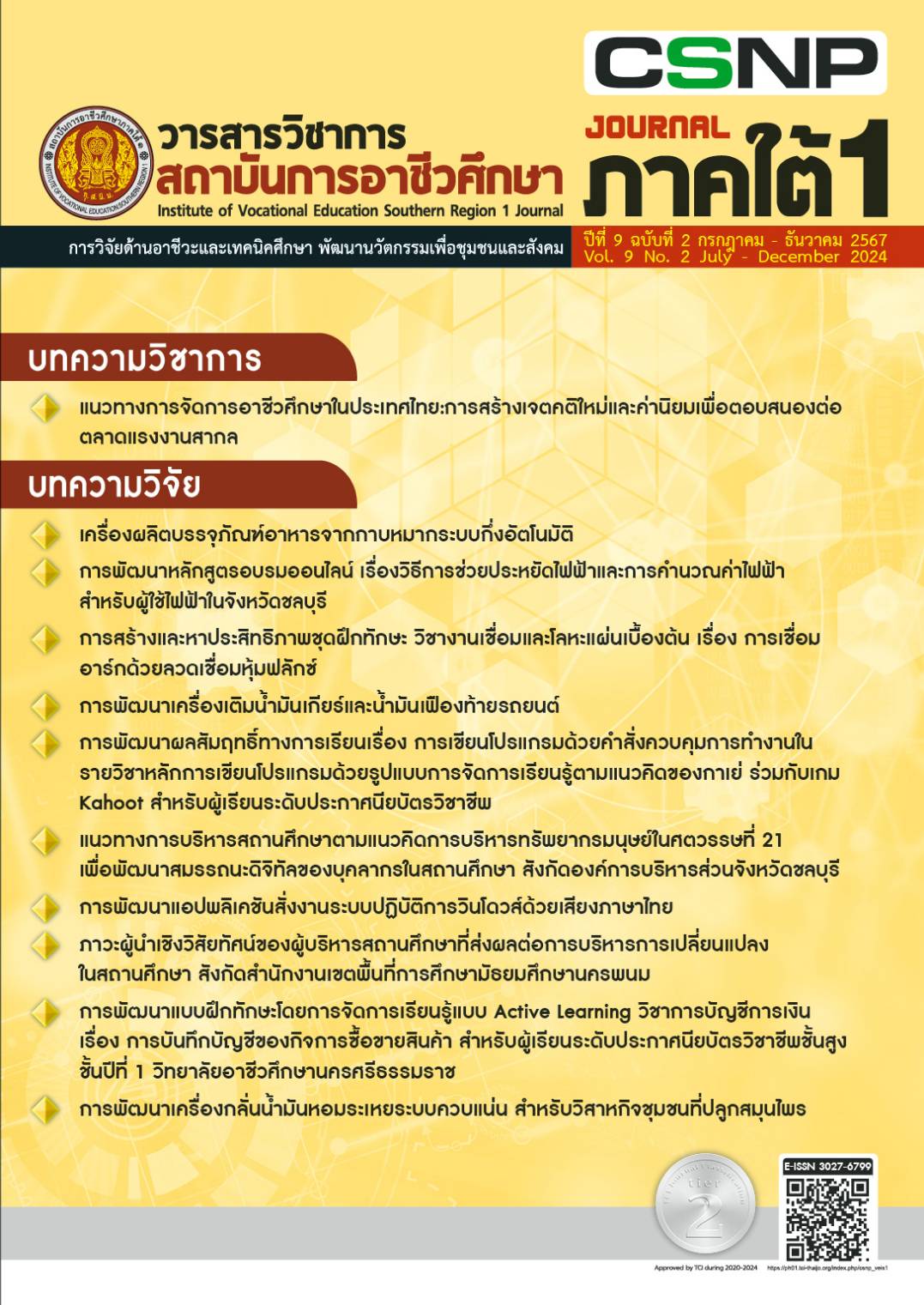The Constructionism Learning and Teaching Model to Enhance Self-directed Learning Characteristics for High Vocational Certificate Learners of Lopburi Technical College
Keywords:
Learning and Teaching Model, Constructionism, Self-directed LearningAbstract
The purposes of this research were to: 1) study the principles, theories, current conditions, and desirable learning and teaching, 2) develop the model, 3) implement the model, and 4) evaluate the model implementation. This research and development consisted of 4 steps as follows. The first step dealt with the research population of 326 high vocational certificate students registering in Science for Business and Services Subject (30000-1308) in the semester 1/2023. The samples were 177 students determined using Krejcie and Morgan Table and simple random sampling method. The second step dealt with the 5 experts, derived by purposive sampling, who validated the model quality on the lesson plan and the assessment. The third step and the fourth step dealt with 36 high vocational certificate students in the Department of Management Logistic and Supply Chain obtained by purposive sampling. The research tools included lesson plan, pretest and posttest, a report form, questionnaires, authentic assessment and self-directed learning assessment. The data were analyzed by percentage, average, standard deviation, efficiency analysis E1:E2, and t-test.
The research showed that 1) the principles and theories were analyzed to create the model was at the moderate level in overall. The current condition was moderate while the desirable learning and teaching was at the high level. 2) The model consisted of 3 components, i.e., input, process, and output. The results from the evaluation of the model quality was at the high level. The efficiency of the learning plan on E1:E2 was higher than the set criterion at 80/80. 3) The results of the model implementation showed that the scores of the students after learning were higher than those before learning at statistically significant difference. 4) The evaluation of the model implementation were as follows: 4.1) the summative achievement of learners was higher than the criteria at 88.89 percent followed the hypothesis; 4.2) the results of learners’satisfaction was in overall at the high level; 4.3) the results of the authentic assessment of the learners was in overall at the highest level. Finally, 4.4) the results of self–directed learning assessment of the learners in overall was at the highest level.
References
สถาบันส่งเสริมการสอนวิทยาศาสตร์และเทคโนโลยี. (2566). แถลงข่าวผลการประเมิน PISA 2022. กรุงเทพมหานคร: สถาบันส่งเสริมการสอนวิทยาศาสตร์และเทคโนโลยี.
สำนักงานเลขาธิการสภาการศึกษา. (2558). สถานภาพการผลิตและพัฒนาครูในประเทศไทย. กรุงเทพมหานคร: พริกหวานกราฟฟิค.
ลัพธวรรณ ต้นสกุล. (2564). การศึกษาผลสัมฤทธิ์ทางการเรียนวิชาคณิตศาสตร์ เรื่อง เซต ด้วยการจัดการเรียนรู้โดยใช้ทฤษฎีการสร้างองค์ความรู้ด้วยตนเอง ของผู้เรียนชั้นมัธยมศึกษาปีที่ 4. วิทยานิพนธ์ศึกษาศาสตร์มหาบัณฑิต คณะศึกษาศาสตร์ มหาวิทยาลัยรามคำแหง, กรุงเทพมหานคร.
วิทยาลัยเทคนิคลพบุรี. (2565). ข้อมูลการประเมินการจัดการเรียนรู้ของผู้เรียนที่มีต่อผู้สอน ปีการศึกษา 2565. ลพบุรี: งานวิจัยและพัฒนานวัตกรรม วิทยาลัยเทคนิคลพบุรี.
Sahin, M. C. (2009). Instructional Design Principles for 21st Century Learning Skills. Procedia-Social and Behavioral Sciences. 1(1), 1464-1468.
เรวดี จันทร์รัศมีโชติ, สมโภชน์ อเนกสุข, และพงศ์เทพ จิระโร. (2558). การพัฒนารูปแบบการเรียนรู้ด้วยตนเอง ของผู้เรียนชั้นมัธยมศึกษาปีที่ 3 โดยการประยุกต์ทฤษฎีคอนสตรัคติวิซึมสู่การเรียนรู้ด้วยกระบวนการวิจัย. วารสารศึกษาศาสตร์ มหาวิทยาลัยบูรพา, 26(3), 14-27.
สรพงค์ สุขเกษม, ทิพรัตน์ สิทธิวงศ์, และประหยัด จิระวรพงศ์. (2562). การพัฒนารูปแบบการเรียนการสอนแบบผสมผสาน รายวิชาคอมพิวเตอร์สารสนเทศขั้นพื้นฐาน สำหรับนิสิตระดับปริญญาตรี. วารสารคณะศึกษาศาสตร์ มหาวิทยาลัยนเรศวร, 21(4). 317-328.
กันตาภา สุทธิอาจ, ไพฑูรย์ สินลารัตน์, และไสว ฟักขาว. (2561). การพัฒนารูปแบบการเรียนการสอนแบบเน้นประสบการณ์ตามสภาพจริง เพื่อส่งเสริมคุณลักษณะการเรียนด้วยการนำตนเอง ของนักเรียนชั้นมัธยมศึกษาตอนต้น. วารสารบัณฑิตศึกษา มหาวิทยาลัยราชภัฏวไลยอลงกรณ์ ในพระบรมราชูปถัมภ์, 12(3), 1-15.
พรรณิกา สิทธิแก้ว, และนพพร แหยมแสง. (2564). ผลการจัดกิจกรรมการเรียนรู้คณิตศาสตร์ เรื่อง พื้นที่ผิวและปริมาตร ตามทฤษฎีคอนสตรัคติวิซึม ชั้นมัธยมศึกษาปีที่ 3 โรงเรียนสาธิตมหาวิทยาลัยรามคำแหง. วารสารศึกษาศาสตร์ มหาวิทยาลัยนเรศวร, 23(2), 232-244.
เรวดี เพ็ญศรี. (2565). การพัฒนารูปแบบการจัดการเรียนรู้แบบ SMILE เพื่อส่งเสริมทักษะการเรียนรู้ใน ศตวรรษที่ 21 ด้านทักษะการเรียนรู้และนวัตกรรม รายวิชาวิทยาศาสตร์โลกและอวกาศ. สุโขทัย: โรงเรียนศรีสำโรงชนูปถัมภ์.
ลัดดาวรรณ นนนาภา, และปาริชาติ ประเสริฐสังข์. (2566). การพัฒนาชุดกิจกรรมการเรียนรู้วิทยาศาสตร์ แบบนําตนเองสำหรับผู้เรียนชั้นมัธยมศึกษาปีที่ 1. วารสารวิชาการมหาวิทยาลัยราชภัฏศรีสะเกษ, 17(1), 66-77.
จักรพงษ์ ตรียุทธ์. (2561). การพัฒนากิจกรรมการเรียนรู้โดยใช้ทฤษฎีการสร้างองค์ความรู้ด้วยตนเอง เรื่องเส้นขนาน สำหรับนักเรียนชั้นมัธยมศึกษาปีที่ 2. วิทยานิพนธ์ศึกษาศาสตรมหาบัณฑิต มหาวิทยาลัยรามคำแหง, กรุงเทพมหานคร.
Mintah, J. K. (2003). Authentic Assessment in Physical Education: Prevalence of Use and Perceived Impact on Students' Self-Concept, Motivation, and Skill Achievement. Measurement in Physical Education and Exercise Science, 7(3), 161-174.
เขมกร อนุภาพ. (2560). การใช้การเรียนรู้นำตนเอง เพื่อพัฒนาการเรียนรู้วิชาคอมพิวเตอร์ ของผู้เรียนชั้นประถมศึกษาปีที่ 4. วิทยานิพนธ์ศึกษาศาสตรมหาบัณฑิต สาขาหลักสูตรและการสอน วิทยาลัยครุศาสตร์ มหาวิทยาลัยธุรกิจบัณฑิตย์.
Downloads
Published
Issue
Section
License
Copyright (c) 2024 Institute of Vocational Education Southern Region 1 Journal

This work is licensed under a Creative Commons Attribution-NonCommercial-NoDerivatives 4.0 International License.



